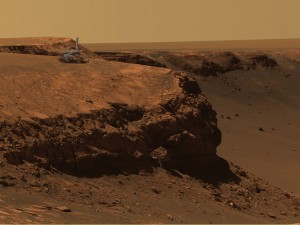 Picture of the edge of Victoria Crater superimposed with
Picture of the edge of Victoria Crater superimposed with
image of the rover Opportunity.
Credit: NASA/JPLMars is not only on the horizon, it's become a sky-high creature of the night...and so, it's time to blog about the Red Planet once again, and to showcase a few favorite pictures from the veteran robots presently exploring that world.
Mars reaches "opposition" on December 24th. This is the time when Earth crosses directly between the Sun and Mars--in other words, when Mars is at the opposite end of the sky from the Sun and at its closest distance from Earth--this time about 55 million miles. You can see Mars yourself in the evening hours if you face east and look high: it's that steady, bright, orange dot right between Gemini and Taurus.
So what's been happening on Mars, exploration-wise? Here's a quick summary on that score:
NASA's Mars Exploration Rovers, Spirit and Opportunity, have had their tours of duty extended a fifth time, which should keep the rovers going--their health willing--possibly through 2009. Having landed on Mars in January of 2004 for a nominal 90 day mission, the robot pair has now lasted almost four years.
Spirit, which landed in the huge Gusev Crater, has traveled four and a half miles from its landing point and is now exploring a range of hills on a volcanic plateau. Probably topping the list of scientific evidence it has turned up is that water, in some form, has altered the chemistry in the environment, sometime in the past.
